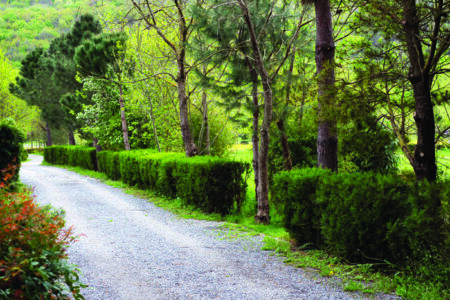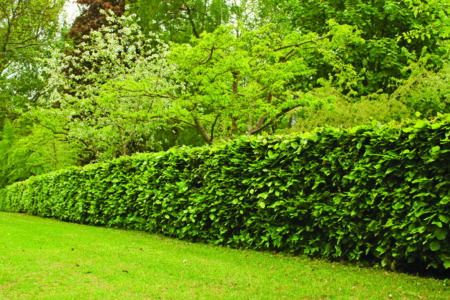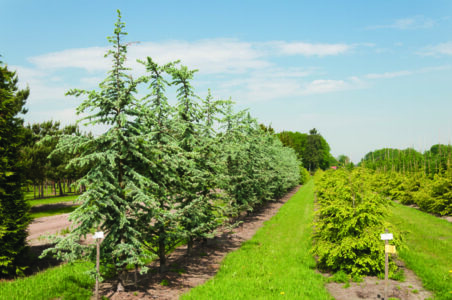Plan out some living privacy fence ideas with this list which highlights the best privacy hedge plants for height, color, or even edibility.
When Esmee Mckee and her family moved to their farm in Owenton, Kentucky, they had more in mind than just growing organic vegetables. Their house faces a road, and one particular goal they had was to create some privacy around their front porch and patio, where they spend time as a family. So, they decided to turn to plants to shield the view of cars passing by.
For the landowner who wants to cultivate a natural-looking landscape while also buffering a noisy roadway or creating a degree of privacy, a living fence or “hedgerow” offers an alternative to expensive wooden privacy fences. These natural barriers are composed of a variety of trees, shrubs, grasses, and groundcovers, typically arranged in a hedge that’s 5 to 10 feet deep.
Nick McCullough, a landscape designer and partner at McCullough’s Landscape & Nursery in New Albany, Ohio, regularly installs living fences for his clients. “Although many people love their neighbors, they don’t want to see them all the time,” he says. While hiring a professional like McCullough is always an option, DIY landowners can effectively install their own living fence with a little forethought and planning.

Selecting Privacy Hedge Plants
When Mckee and her husband began selecting plants for their living privacy fence, they turned to ones they knew grew well in their area. They wanted mostly trees and year-round coverage, so they chose evergreens — blue spruces and pines — as the backbone of their living fence. Then they filled in gaps with faster-growing ornamental grasses to provide coverage while the trees matured, as well as other plants they liked, such as lilacs, spirea, and even a Japanese maple.
McCullough recommends taking a cue from Mckee and giving some forethought to the contents of your hedge before you stock up at the nursery. As with all landscape plants, you need to pay attention to the conditions of your land and climate. “Is your site sunny or shaded? What’s your soil type? Is it well-drained or wet? Answering these questions and finding plants that fit your conditions are the best places to start,” McCullough says.


Beyond that, he recommends thinking about your goals for the space. If, like Mckee, you want year-round coverage, start with a base of evergreen trees and shrubs. But, if you’re only concerned about seasonal coverage, deciduous plants that lose their leaves in the fall may work. For more privacy, select plants with dense foliage, and if you want quick results, seek out faster-growing species that will help you achieve immediate privacy, like Mckee did with ornamental grasses. Pay attention to the height and spread of the mature plants, particularly if you want a natural hedge that doesn’t require regular pruning.
Native Plants for Living Privacy Fence Ideas
Living fences also offer the benefit of ecological diversity, so consider what the plants can do for your landscape in addition to your privacy needs. Do you want to attract songbirds, mitigate erosion, or provide a windbreak? Choose plants that offer these features. Stay away from invasive species, which “reproduce in an aggressive way,” McCullough cautions. Make sure to check the invasive species list for your area before you plant.

Your best bet is to stick with native plants, as they support local wildlife and are adapted to local conditions, making them easier to grow. Your local extension office, master gardeners, or native plant nursery can help you think through the options, but the following trees and shrubs are McCullough’s go-tos. These North American natives can be grown in most areas with minimal maintenance. Consider them for the backbone of your living fence, and then interplant with other natives that have varying textures, colors, and bloom times to add visual interest throughout the year.
Arrowwood Viburnum: Fall Showstopper
For a hedge plant that’ll add swaths of color to your outdoor living area, add arrowwood viburnum (Viburnum dentatum). The dense, upright shrub is durable and beautiful. In spring, it boasts creamy white flower clusters, called “corymbs,” that attract a host of pollinators, including the hummingbird moth and red admiral butterfly. Later, it produces bluish-black fruits that songbirds love to eat. However, this shrub really shines in fall, when its dark green leaves give way to warm shades of yellow, red, and maroon. Choose your cultivar based on the shades you want to see in the autumn landscape: ‘Emerald Lustre’ for yellow-bronze foliage, ‘Morton’ for burgundy, ‘Synnestvedt’ for reddish-purple, or ‘Ralph Senior’ for a colorful mix.

Native to the eastern United States and hardy from Zones 2 to 8, arrowwood viburnum is easy to transplant and grows from 5 to 10 feet tall. It’s adaptable to a range of soils, from wet to dry and basic to acidic. It isn’t susceptible to many pests or diseases; though the viburnum leaf beetle is its main foe, affected branches can easily be pruned to minimize the damage. Occasional pruning is needed to control height and sucker spread. The shallow root system also benefits from light mulching to conserve moisture and minimize temperature fluctuations. While this plant has very few downsides, be aware that the flowers have a pungent odor that some describe as unpleasant.
Red Cedar: Easy Windbreak
If you’re looking for something quick-growing, consider the eastern red cedar (Juniperus virginiana), which can grow 1 to 2 feet in height per year. Landowners in the eastern United States often view this tree as a pastureland weed due to its quick-spreading growth habit, but it’s also a superb plant that has a lot to offer in terms of wind protection and wildlife habitat. The eastern red cedar is one of the most sought-after windbreak plants.

Eastern red cedar is a sought-after, quick growing windbreak that bears clumps of bluish-white berries. These shrubs can grow to be 30 feet tall.
McCullough recommends the cultivar ‘Canaertii,’ which can grow more than 30 feet tall with an 8- to 15-foot spread and has a tight pyramidal shape that loosens with age. It bears clumps of bluish-white fruit that add touches of color to an otherwise dark green backdrop. In addition to tolerating wind, it grows well in a wide range of soil and weather conditions.
Eastern red cedars do best in sun to partial shade. They need regular watering until established, but require very little maintenance thereafter. The tree is relatively pest-resistant thanks to its fragrant wood and foliage, though it’s susceptible to bagworms, which can be picked off by hand or treated with Bacillus thuringiensis (Bt). It’s also susceptible to cedar apple rust, a fungus that affects apple trees, so take care if you’re planting near orchards.

Canadian Hemlock: Shade-Loving Screen
For a softer, airier evergreen backdrop, look into the shade-loving Canadian hemlock (Tsuga canadensis). While its open growth habit lends itself to a hands-off natural hedge, it also responds well to pruning for a more manicured look. As an added bonus, it has very little needle drop, meaning less mess for you to clean up.

If you want year-round coverage from your living fence, start with a base of evergreens.
Of the hedge plants on this list, the Canadian hemlock requires the most in terms of care. It does best when transplanted into slightly acidic, well-drained soil high in organic matter; will need to be staked for the first 2 to 3 years; and requires regular watering until established. Canadian hemlock doesn’t do well in extreme weather conditions, including drought and wind, and prefers Zones 3 to 7. The hemlock woolly adelgid, a sap-sucking relative of the aphid, is a big threat to the species, and the shrubs may need to be treated with horticultural oils to prevent infestation. But if you’re looking for a hedge plant to grow in a shady area, the Canadian hemlock is well worth the extra effort, as it’s one of the few that tolerates shade.
You can choose from more than 50 cultivars of Canadian hemlock that vary in size, shape, and foliage color. Dwarf forms like ‘Lewis’ reach only up to 8 feet tall. While trees can grow up to 70 feet tall in the wild, the shorter, weepy cultivars are better suited to living privacy fences. Look for ‘Sargentii’ or ‘Cole’s Prostrate’ for a natural hedge, and more columnar forms like ‘Monler’ for a manicured hedge.

Airy, shade-loving Canadian hemlock trees may vary in shape, size, and foliage color.
Blackhaw Viburnum: Edible Privacy Hedge Plant
For the landowner seeking a dual-purpose hedge that provides privacy as well as food, the blackhaw viburnum (Viburnum prunifolium) grows in Zones 3 to 9. Its berry-like autumn fruits, called drupes, can be eaten fresh off the bush or harvested for jams and preserves. For ultimate fruit production, the shrub needs at least half a day of sunlight.

While blackhaw viburnum flowers in the spring, in the fall, it bears berry-like fruits that make wonderful preserves.
Blackhaw viburnum has a twiggy growth that reaches heights of up to 15 feet with a 12-foot spread. This deer-resistant plant will tolerate drought, shade, and clay soil. It has very little pest or disease pressure, though powdery mildew may set in during late summer. Pollinators love the shrub, which is host to the azure butterfly. Like its cousin, the arrowwood viburnum, the blackhaw flowers in spring and boasts an array of color in fall. Cultivars to consider are ‘Guazam,’ with crimson foliage in fall, and ‘Summer Magic,’ with a shinier, more leathery summer leaf.

Chokeberries: Wetland Wall
If you’re looking for a hedge plant that will thrive in boggy conditions, check out the purple-fruited chokeberry (Aronia × prunifolia), a cross between the black and red chokeberries. It’s an ideal choice for privacy hedges situated near ponds or streams, though it will tolerate a range of soil types.
The chokeberry produces brilliant red fall foliage and, as its name indicates, attractive purple fruit. While the fruits are too bitter to be palatable for humans, they’re an excellent food source for winter and migratory birds, and have recently grown in popularity as a supplement high in antioxidants. The flowers also attract bees, butterflies, and hummingbirds, while the foliage offers cover to small mammals. This shrub is hardy in Zones 4 to 7, and grows to heights of 6 to 12 feet with a 6- to 9-foot spread. There are no significant disease or pest issues, though it’s occasionally susceptible to leaf spots and leaf or twig blight.

.The purple-fruited chokeberry produces brilliant fall foliage and lovely purple fruit.
Tips for Planting Your Living Privacy Fence Ideas
Cluster plantings are installations of plants in odd-number groupings that allow you to create an attractive screen of privacy, while providing small windbreaks or nooks for wildlife. According to the Penn State Extension, by working in small clusters, you can create a more natural-feeling hedge that avoids looking like a wall of trees or shrubbery. You can also situate the clusters to create walkways through your property or allow for airflow.
Staggered rows offer a more wall-like appearance that can work well for rigidly defined borders or when your goal is to block noise. The Penn State Extension recommends spacing your plantings based on the average diameter of the mature plants. Plant the trees or shrubs in two or three rows, depending on the degree of barrier you wish to achieve, staggering the rows to better fill in gaps between plants.
Personalized Privacy
The great thing about a living fence is that you can tweak the design to work for you. Add more base plants to extend the length of your fence, add depth, or change the shape. Interplant your fence with ornamentals that add texture or color. When it comes to living fences, boring wood planks are out, and your imagination can run free to create a cozy area all your own.
Rachael Dupree is a writer and beginning farmer who grows food and medicinal plants for her family on 50 acres near Lexington, Kentucky.